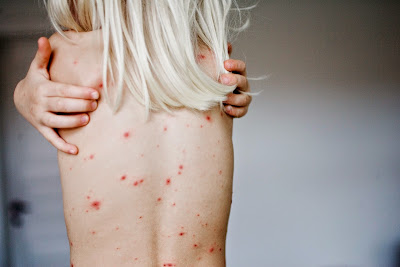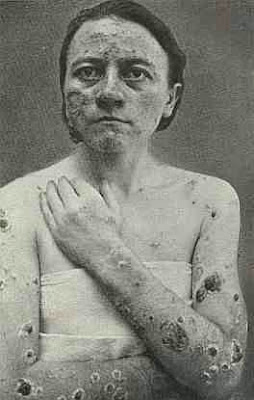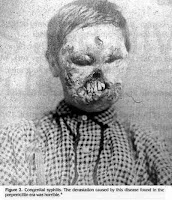Syphilis
Syphilis is a highly contagious disease
spread primarily by sexual activity, including oral and anal sex.
Occasionally, the disease can be passed to another person through
prolonged kissing or close bodily contact. Although this disease is
spread from sores, the vast majority of those sores go unrecognized. The
infected person is often unaware of the disease and unknowingly passes
it on to his or her sexual partner.
 Pregnant women with the disease can spread it to their baby. This disease, called congenital syphilis, can cause abnormalities or even death to the child.
Pregnant women with the disease can spread it to their baby. This disease, called congenital syphilis, can cause abnormalities or even death to the child.
Syphilis cannot be spread by toilet seats, door knobs, swimming pools, hot tubs, bath tubs, shared clothing, or eating utensils.
Syphilis is caused by the bacteria Treponema pallidum.
Syphilis was once a major public health threat, commonly causing serious long-term health problems such as arthritis, brain damage, and blindness. It defied effective treatment until the late 1940s, when the antibiotic penicillin was first developed.
According
to the CDC, the rate of new cases of syphilis had plummeted in the
1990's and in the year 2000 it reached an all time low since reporting
began in 1941. However, new cases of syphillis doubled between 2005 and
2013 from 8,724 to 16,663.
Syphilis infection occurs in three distinct stages:
Early or primary syphilis.
People with primary syphilis will develop one or more sores. The sores
are usually small painless ulcers. They occur on the genitals or in or
around the mouth somewhere between 10-90 days (average three weeks)
after exposure. Even without treatment they heal without a scar within
six weeks.
The secondary stage
may last one to three months and begins within six weeks to six months
after exposure. People with secondary syphilis experience a rosy "copper
penny" rash
typically on the palms of the hands and soles of the feet. However,
rashes with a different appearance may occur on other parts of the body,
sometimes resembling rashes caused by other diseases. They may also
experience moist warts in the groin, white patches on the inside of the mouth, swollen lymph glands, fever, and weight loss. Like primary syphilis, secondary syphilis will resolve without treatment.
 |
| From the 15th century onwards, syphilis spread throughout Europe and beyond. Most of the supposed cures were almost as bad as the disease itselfs |
Latent syphilis. This is where the infection lies dormant (inactive) without causing symptoms.
Tertiary syphilis. If the infection isn't treated, it may then progress to a stage characterized by severe problems with the heart, brain, and nerves that can result in paralysis, blindness, dementia, deafness, impotence, and even death if it's not treated.
History of syphilis
Syphilis is believed to have infected 12 million additional people in 1999, with greater than 90% of cases in the developing world. It affects between 700,000 and 1.6 million pregnancies a year, resulting in spontaneous abortions, stillbirths, and congenital syphilis.During 2010 it caused about 113,000 deaths down from 202,000 in 1990. In sub-Saharan Africa, syphilis contributes to approximately 20% of perinatal deaths. Rates are proportionally higher among intravenous drug users, those who are infected with HIV, and men who have sex with men. In the United States, rates of syphilis as of 2007 were six times greater in men than women, while they were nearly equal in 1997. African Americans accounted for almost half of all cases in 2010.
Syphilis was very common in Europe during the 18th and 19th centuries. In the developed world during the early 20th century, infections declined rapidly with the widespread use of antibiotics, until the 1980s and 1990s. Since the year 2000, rates of syphilis have been increasing in the USA, Canada, the UK, Australia and Europe, primarily among men who have sex with men. Rates of syphilis among American women have, however, remained stable during this time, and rates among UK women have increased, but at a rate less than that of men. Increased rates among heterosexuals have occurred in China and Russia since the 1990s.This has been attributed to unsafe sexual practices, such as sexual promiscuity, prostitution, and decreasing use of barrier protection.

Untreated, it has a mortality of 8% to 58%, with a greater death rate in males. The symptoms of syphilis have become less severe over the 19th and 20th centuries, in part due to widespread availability of effective treatment and partly due to decreasing virulence of the spirochaete. With early treatment, few complications result. Syphilis increases the risk of HIV transmission by two to five times, and coinfection is common (30–60% in a number of urban centers).
The exact origin of syphilis is disputed. Syphilis was indisputably present in the Americas before European contact. The dispute is over whether or not syphilis was also present elsewhere in the world at that time. One of the two primary hypotheses proposes that syphilis was carried from the Americas to Europe by the returning crewmen from Christopher Columbus's voyage to the Americas. The other hypothesis says that syphilis existed in Europe previously, but went unrecognized until shortly after Columbus' return. These are referred to as the Columbian and pre-Columbian hypotheses, respectively. The Columbian hypothesis is best supported by the available evidence. The first written records of an outbreak of syphilis in Europe occurred in 1494 or 1495 in Naples, Italy, during a French invasion (Italian War of 1494–98). Due to its being spread by returning French troops, it was initially known as the "French disease".
In 1530, the name "syphilis" was first used by the Italian physician and poet Girolamo Fracastoro as the title of his Latin poem in dactylic hexameter describing the ravages of the disease in Italy. It was also known historically as the "Great Pox".
The causative organism, Treponema pallidum, was first identified by Fritz Schaudinn and Erich Hoffmann in 1905. The first effective treatment (Salvarsan) was developed in 1910 by Paul Ehrlich, which was followed by trials of penicillin and confirmation of its effectiveness in 1943. Before the advent of effective treatment, mercury and isolation were commonly used, with treatments often worse than the disease.

References
- Gao, L; Zhang, L; Jin, Q (September 2009). "Meta-analysis: prevalence of HIV infection and syphilis among MSM in China". Sexually transmitted infections 85 (5): 354–8. doi:10.1136/sti.2008.034702. PMID 19351623.
- Karp, G; Schlaeffer, F; Jotkowitz, A; Riesenberg, K (January 2009). "Syphilis and HIV co-infection". European journal of internal medicine 20 (1): 9–13. doi:10.1016/j.ejim.2008.04.002. PMID 19237085.
- Kent ME, Romanelli F (February 2008). "Reexamining syphilis: an update on epidemiology, clinical manifestations, and management". Annals of Pharmacotherapy 42 (2): 226–36. doi:10.1345/aph.1K086. PMID 18212261.
- Stamm LV (February 2010). "Global Challenge of Antibiotic-Resistant Treponema pallidum". Antimicrob. Agents Chemother. 54 (2): 583–9. doi:10.1128/AAC.01095-09. PMC 2812177. PMID 19805553.
- White, RM (13 March 2000). "Unraveling the Tuskegee Study of Untreated Syphilis". Archives of Internal Medicine 160 (5): 585–98. doi:10.1001/archinte.160.5.585. PMID 10724044.
- Committee on Infectious Diseases (2006). Larry K. Pickering, ed. Red book 2006 Report of the Committee on Infectious Diseases (27th ed.). Elk Grove Village, IL: American Academy of Pediatrics. pp. 631–44. ISBN 978-1-58110-207-9.
- Eccleston, K; Collins, L; Higgins, SP (March 2008). "Primary syphilis". International journal of STD & AIDS 19 (3): 145–51. doi:10.1258/ijsa.2007.007258. PMID 18397550.
- Mullooly, C; Higgins, SP (August 2010). "Secondary syphilis: the classical triad of skin rash, mucosal ulceration and lymphadenopathy". International journal of STD & AIDS 21 (8): 537–45. doi:10.1258/ijsa.2010.010243. PMID 20975084.
- Dylewski J, Duong M (2 January 2007). "The rash of secondary syphilis". Canadian Medical Association Journal 176 (1): 33–5. doi:10.1503/cmaj.060665. PMC 1764588. PMID 17200385.
- Bhatti MT (2007). "Optic neuropathy from viruses and spirochetes". Int Ophthalmol Clin 47 (4): 37–66, ix. doi:10.1097/IIO.0b013e318157202d. PMID 18049280.












































I was diagnosed as HEPATITIS B carrier in 2013 with fibrosis of the
ReplyDeleteliver already present. I started on antiviral medications which
reduced the viral load initially. After a couple of years the virus
became resistant. I started on HEPATITIS B Herbal treatment from
ULTIMATE LIFE CLINIC (www.ultimatelifeclinic.com) in March, 2020. Their
treatment totally reversed the virus. I did another blood test after
the 6 months long treatment and tested negative to the virus. Amazing
treatment! This treatment is a breakthrough for all HBV carriers.